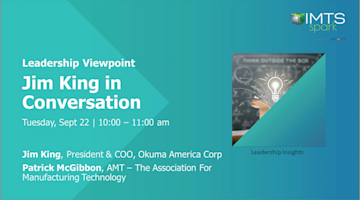The U.S. government has consistently shown that it can come together and act swiftly to provide short-term support in times of crisis. But when it comes to a vision for the future, bipartisanship falls apart, becoming more about political ideology than leadership, despite the common goals of national security, public safety, job creation, and economic growth.
Back in 2008, AMT first issued its Manufacturing Mandate, which called for a national strategy focused on strengthening the U.S. manufacturing sector. Back then, the Mandate emphasized the importance of collaboration between government, private industries, and schools to increase manufacturing innovation, enhance global competitiveness, and build a 21st-century workforce (a national “Smartforce”).
Those ideas are still relevant today, but the industry has changed, along with the world, over the last decade. Manufacturing still plays a critical role in job creation, innovation, economic growth, and national security, but the needs are different. Advancements in technology have transformed the industry, and unfortunately, the federal response has not kept pace. The government must put manufacturing at the top of our national agenda. Both President Donald Trump and Democratic presidential candidate Joe Biden make manufacturing central to their campaign platforms.
What can the government do now to support a secure future for manufacturing? It can start by engaging all stakeholders in identifying challenges, planning a strategy, and coming up with solutions. Representatives from federal, state, and local governments, industry, labor, schools, and community organizations must be at the table. Below are a few other recommendations:
Invest in innovation
Develop a technology framework that makes it easier to access and adopt the technologies key to manufacturing productivity and efficiency. Provide tools to startups and small businesses to grow. Adopt tax and regulatory policies that encourage investments in new processes, plants, and equipment.
End the skills gap
Promote STEM and technical career pathways. Support industry-recognized credentialing and apprenticeship programs for key job functions of the future. Increase broadband access to all areas of the country.
Increase competitiveness
Invest in a comprehensive national infrastructure plan that modernizes our transportation, energy, and telecommunications systems. Recognize that we live in a globalized world by building international relationships and entering into mutually beneficial trade agreements. Create a fair and open trade environment with avenues to address trade violators directly.
Ensure a strong U.S. industrial base
Preserve traditional defense manufacturing sectors and engage advanced manufacturing and technology sectors. Mitigate supply chain vulnerabilities by relying on domestic sources for defense needs when possible.
These recommendations call for in-depth analyses and thoughtful solutions. Stay tuned for an updated version of AMT’s Manufacturing Mandate for moving manufacturing forward coming this fall.






